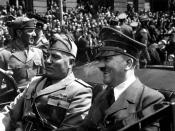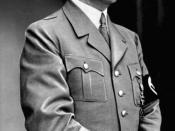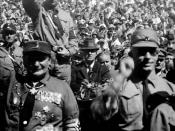Describe the development of the Nazi Party in Germany
(1922-1939), and analyse Hitler's role in this.
In order to analyse the Nazi Party's development through 1922-1939 it is crucial that we examine those fundamental aspects concerning the historical and contemporary factors surrounding both the formation of the Nazi Party, and Hitler's contribution to the party both before and after the Nazi regime came to power. This being historically the unpopularity of the Weimar Republic, demonstrated by political unrest and economic instability. The contemporary factors being the apparent economic boom fuelled by the Dawes Plan and the disastrous effects of the Wall Street Crash resulting in mass unemployment, the parties close links with the Sturm Abteilung (SA or Brown Shirts), the Nazi's focus on German unemployment and how this was directly related to the Nazi Party's rise in electoral strength, and finally the Nazi's method of administration and it's effecting results throughout the 1930's.
In addition to this it is essential that we analyse the party's propagandist system, this in relation to Hitler and Hitler's own self-development aiding a 'cult of personality' and the then, developing effect on both the party internally and external party popularity. The degree to which Mein Kampf can be seen as a blueprint not only for World War II, but also as a manifesto for the Nazi regime throughout it's period in office, and considering these points, to what extent Hitler was in sole command of the party as opposed to the party being in control of him.
The formation and continued development of the Nazi Party like many other political parties in Germany at the time was closely linked to the unpopularity of the Weimar Republic, a direct result of political unrest characterised by economic instabilities and the lack of...



Good work.
Hey on your next Essay make sure to take out the \"<Tab/>&lt\" Dont worry i did it on my first Essay.
2 out of 2 people found this comment useful.